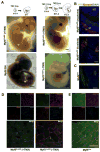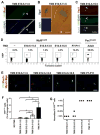Myf5 expression during fetal myogenesis defines the developmental progenitors of adult satellite cells
- PMID: 23639729
- PMCID: PMC3679295
- DOI: 10.1016/j.ydbio.2013.04.021
Myf5 expression during fetal myogenesis defines the developmental progenitors of adult satellite cells
Abstract
Myf5 is a member of the muscle-specific determination genes and plays a critical role in skeletal muscle development. Whereas the expression of Myf5 during embryonic and fetal myogenesis has been extensively studied, its expression in progenitors that will ultimately give rise to adult satellite cells, the stem cells responsible for muscle repair, is still largely unexplored. To investigate this aspect, we have generated a mouse strain carrying a CreER coding sequence in the Myf5 locus. In this strain, Tamoxifen-inducible Cre activity parallels endogenous Myf5 expression. Combining Myf5(CreER) and Cre reporter alleles, we were able to evaluate the contribution of cells expressing Myf5 at distinct developmental stages to the pool of satellite cells in adult hindlimb muscles. Although it was possible to trace back the origin of some rare satellite cells to a subpopulation of Myf5(+ve) progenitors in the limb buds at the late embryonic stage (∼E12), a significant number of satellite cells arise from cells which expressed Myf5 for the first time at the fetal stage (∼E15). These studies provide direct evidence that adult satellite cells derive from progenitors that first express the myogenic determination gene Myf5 during fetal stages of myogenesis.
Published by Elsevier Inc.
Figures






Similar articles
-
Ancestral Myf5 gene activity in periocular connective tissue identifies a subset of fibro/adipogenic progenitors but does not connote a myogenic origin.Dev Biol. 2014 Jan 15;385(2):366-79. doi: 10.1016/j.ydbio.2013.08.010. Epub 2013 Aug 19. Dev Biol. 2014. PMID: 23969310 Free PMC article.
-
Loss of MyoD and Myf5 in Skeletal Muscle Stem Cells Results in Altered Myogenic Programming and Failed Regeneration.Stem Cell Reports. 2018 Mar 13;10(3):956-969. doi: 10.1016/j.stemcr.2018.01.027. Epub 2018 Mar 1. Stem Cell Reports. 2018. PMID: 29478898 Free PMC article.
-
Embryonic founders of adult muscle stem cells are primed by the determination gene Mrf4.Dev Biol. 2013 Sep 1;381(1):241-55. doi: 10.1016/j.ydbio.2013.04.018. Epub 2013 Apr 25. Dev Biol. 2013. PMID: 23623977
-
The molecular regulation of muscle stem cell function.Cold Spring Harb Symp Quant Biol. 2008;73:323-31. doi: 10.1101/sqb.2008.73.064. Epub 2009 Mar 27. Cold Spring Harb Symp Quant Biol. 2008. PMID: 19329572 Review.
-
Function of the myogenic regulatory factors Myf5, MyoD, Myogenin and MRF4 in skeletal muscle, satellite cells and regenerative myogenesis.Semin Cell Dev Biol. 2017 Dec;72:19-32. doi: 10.1016/j.semcdb.2017.11.011. Epub 2017 Nov 15. Semin Cell Dev Biol. 2017. PMID: 29127046 Review.
Cited by
-
Established cell surface markers efficiently isolate highly overlapping populations of skeletal muscle satellite cells by fluorescence-activated cell sorting.Skelet Muscle. 2016 Nov 8;6:35. doi: 10.1186/s13395-016-0106-6. eCollection 2016. Skelet Muscle. 2016. PMID: 27826411 Free PMC article.
-
The chemokine receptor CXCR4 regulates satellite cell activation, early expansion, and self-renewal, in response to skeletal muscle injury.Front Cell Dev Biol. 2022 Sep 22;10:949532. doi: 10.3389/fcell.2022.949532. eCollection 2022. Front Cell Dev Biol. 2022. PMID: 36211464 Free PMC article.
-
Satellite cells: regenerative mechanisms and applicability in muscular dystrophy.Stem Cells Int. 2015;2015:487467. doi: 10.1155/2015/487467. Epub 2015 Feb 11. Stem Cells Int. 2015. PMID: 25763072 Free PMC article. Review.
-
Canonical WNT/β-Catenin Signaling Plays a Subordinate Role in Rhabdomyosarcomas.Front Pediatr. 2018 Dec 5;6:378. doi: 10.3389/fped.2018.00378. eCollection 2018. Front Pediatr. 2018. PMID: 30568936 Free PMC article.
-
Ancestral Myf5 gene activity in periocular connective tissue identifies a subset of fibro/adipogenic progenitors but does not connote a myogenic origin.Dev Biol. 2014 Jan 15;385(2):366-79. doi: 10.1016/j.ydbio.2013.08.010. Epub 2013 Aug 19. Dev Biol. 2014. PMID: 23969310 Free PMC article.
References
-
- Armand O, Boutineau AM, Mauger A, Pautou MP, Kieny M. Origin of satellite cells in avian skeletal muscles. Arch Anat Microsc Morphol Exp. 1983;72:163–181. - PubMed
-
- Atit R, Sgaier SK, Mohamed OA, Taketo MM, Dufort D, Joyner AL, Niswander L, Conlon RA. Beta-catenin activation is necessary and sufficient to specify the dorsal dermal fate in the mouse. Dev Biol. 2006;296:164–176. - PubMed
-
- Biressi S, Messina G, Collombat P, Tagliafico E, Monteverde S, Benedetti L, Cusella De Angelis MG, Mansouri A, Ferrari S, Tajbakhsh S, Broccoli V, Cossu G. The homeobox gene Arx is a novel positive regulator of embryonic myogenesis. Cell Death Differ. 2008;15:94–104. - PubMed
Publication types
MeSH terms
Substances
Grants and funding
LinkOut - more resources
Full Text Sources
Other Literature Sources
Medical
Molecular Biology Databases
Research Materials

